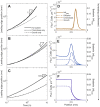Influence of confinement on the spreading of bacterial populations
- PMID: 35533196
- PMCID: PMC9119553
- DOI: 10.1371/journal.pcbi.1010063
Influence of confinement on the spreading of bacterial populations
Abstract
The spreading of bacterial populations is central to processes in agriculture, the environment, and medicine. However, existing models of spreading typically focus on cells in unconfined settings-despite the fact that many bacteria inhabit complex and crowded environments, such as soils, sediments, and biological tissues/gels, in which solid obstacles confine the cells and thereby strongly regulate population spreading. Here, we develop an extended version of the classic Keller-Segel model of bacterial spreading via motility that also incorporates cellular growth and division, and explicitly considers the influence of confinement in promoting both cell-solid and cell-cell collisions. Numerical simulations of this extended model demonstrate how confinement fundamentally alters the dynamics and morphology of spreading bacterial populations, in good agreement with recent experimental results. In particular, with increasing confinement, we find that cell-cell collisions increasingly hinder the initial formation and the long-time propagation speed of chemotactic pulses. Moreover, also with increasing confinement, we find that cellular growth and division plays an increasingly dominant role in driving population spreading-eventually leading to a transition from chemotactic spreading to growth-driven spreading via a slower, jammed front. This work thus provides a theoretical foundation for further investigations of the influence of confinement on bacterial spreading. More broadly, these results help to provide a framework to predict and control the dynamics of bacterial populations in complex and crowded environments.
Conflict of interest statement
The authors have declared that no competing interests exist.
Figures







Similar articles
-
Chemotactic migration of bacteria in porous media.Biophys J. 2021 Aug 17;120(16):3483-3497. doi: 10.1016/j.bpj.2021.05.012. Epub 2021 May 20. Biophys J. 2021. PMID: 34022238 Free PMC article.
-
A traveling-wave solution for bacterial chemotaxis with growth.Proc Natl Acad Sci U S A. 2021 Nov 30;118(48):e2105138118. doi: 10.1073/pnas.2105138118. Proc Natl Acad Sci U S A. 2021. PMID: 34819366 Free PMC article.
-
Mathematical description of bacterial traveling pulses.PLoS Comput Biol. 2010 Aug 19;6(8):e1000890. doi: 10.1371/journal.pcbi.1000890. PLoS Comput Biol. 2010. PMID: 20808878 Free PMC article.
-
Migration of chemotactic bacteria in soft agar: role of gel concentration.Biophys J. 2011 Aug 3;101(3):525-34. doi: 10.1016/j.bpj.2011.06.023. Biophys J. 2011. PMID: 21806920 Free PMC article.
-
Overview of mathematical approaches used to model bacterial chemotaxis II: bacterial populations.Bull Math Biol. 2008 Aug;70(6):1570-607. doi: 10.1007/s11538-008-9322-5. Epub 2008 Jul 19. Bull Math Biol. 2008. PMID: 18642047 Review.
Cited by
-
Proliferating active matter.Nat Rev Phys. 2023 May 31:1-13. doi: 10.1038/s42254-023-00593-0. Online ahead of print. Nat Rev Phys. 2023. PMID: 37360681 Free PMC article. Review.
-
Role of a single MCP in evolutionary adaptation of Shewanella putrefaciens for swimming in planktonic and structured environments.Appl Environ Microbiol. 2025 Apr 23;91(4):e0022925. doi: 10.1128/aem.00229-25. Epub 2025 Mar 25. Appl Environ Microbiol. 2025. PMID: 40130843 Free PMC article.
-
Spatio-temporal patterns in growing bacterial suspensions.Sci Rep. 2025 Aug 22;15(1):30948. doi: 10.1038/s41598-025-13297-5. Sci Rep. 2025. PMID: 40846879 Free PMC article.
-
Pattern formation along signaling gradients driven by active droplet behavior of cell swarms.Proc Natl Acad Sci U S A. 2025 May 27;122(21):e2419152122. doi: 10.1073/pnas.2419152122. Epub 2025 May 20. Proc Natl Acad Sci U S A. 2025. PMID: 40392846 Free PMC article.
-
Surface tension coupled non-uniformly imposed flows modulate the activity of reproducing chemotactic bacteria in porous media.Sci Rep. 2023 Apr 5;13(1):5561. doi: 10.1038/s41598-023-31753-y. Sci Rep. 2023. PMID: 37019986 Free PMC article.
References
-
- Chaban B, Hughes HV, Beeby M. The flagellum in bacterial pathogens: for motility and a whole lot more. In: Seminars in cell and developmental biology. vol. 46. Elsevier; 2015. p. 91–103. - PubMed
Publication types
MeSH terms
LinkOut - more resources
Full Text Sources

